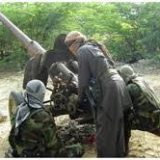US Counterterrorism strikes: Tempo remains high in Somalia and Yemen, transparency improves

Saturday July 28, 2018
For more than a decade, the United States has been engaged in air campaigns against jihadists in what the Obama administration referred to as areas “outside of active hostilities,” or active war zones such as Afghanistan, Iraq, and Syria.
FDD’s Long War Journal tracks these counterterrorism air campaigns in Yemen, Somalia, Pakistan and Libya from press releases, media reports and correspondence with the relevant combatant commands. LWJ has visualized this data in interactive maps and timelines, which are available online.
In 2017, LWJ reported unprecedented levels of airstrikes in Somalia and Yemen.
Thus far in 2018, the United States has sustained its high strike tempo in Somalia and increased transparency on its air campaign in Yemen.
Strikes in Pakistan have leveled off, although press restrictions make tracking operations there difficult. In Libya, the US has targeted jihadists sparingly.
Somalia
The rate of US strikes against Shabaab in Somalia is similar to last year’s record high. In 2017, the United States conducted a record 31 strikes against Shabaab, more than the entire decade-long air campaign combined.
With 16 strikes against Shabaab thus far in 2018, the United States is currently on track to meet or exceed that number.
Strikes against the Islamic State, however, have ceased. In Nov. 2017, UA Africa Command (AFRICOM) conducted its first strikes against the Islamic State, conducting four total that month. AFRICOM reports it has not targeted the Islamic State’s branch in Somalia thus far in 2018.
AFRICOM has maintained that both Shabaab and the Islamic State remain a threat to the US and its allies, and will continue to strike as necessary.
“U.S. forces will continue to use all authorized and appropriate measures to protect U.S. citizens and to disable terrorist threats.
This includes partnering with AMISOM and Somali National Security Forces (SNSF) in combined counterterrorism operations and targeting terrorists, their training camps, and their safe havens throughout Somalia and the region.
Together with other international partners, the United States is committed to providing Somalia and AMISOM forces with support in the fight against al-Shabaab and ISIS,” AFRICOM spokesperson Samantha Reho told Long War Journal.
Yemen
American counterterrorism strikes in Yemen have decreased precipitously from last year’s record high of 131, which was more than the previous four years combined.
At the current rate, roughly half as many will be conducted this year. That said, with 31 strikes thus far in 2018, the United States is on pace to surpass the strike total for each previous year, except 2017.
The US military’s transparency on its Yemen air campaign has improved dramatically. US Central Command (CENTCOM) provided Long War Journal with details on the strike locations, dates, and militant groups targeted — information not available since late 2016.
The newly revealed data provides insight into the geographic scope of the American air campaign, as well as the eastern reach of Al Qaeda’s Yemen branch. In 2017, publicized strikes were concentrated in the central governorates of Al Bayda and Marib.
Thus far in 2018, the United States has conducted eight strikes in Hadramawt and four strikes in Shabwah, both eastern governorates that were supposedly cleared of the Al-Qaeda group. CENTCOM kept up pressure on terrorist groups in central Yemen, conducting 16 strikes in Al Bayda, one of which targeted the Islamic State group. Al Qaeda in the Arabian Peninsula is the primary target of the US air campaign.
“Every strike advances the defeat of violent extremist organizations, and protects the United States and partner nations from attack at home and abroad,” said Lt. Col. Earl Brown, a CENTCOM spokesperson, in a press release earlier this year.
Libya
AFRICOM has conducted four strikes in Libya in 2018. Although this is dramatically lower than the over 400 strikes conducted in 2016 as part of Operation Odyssey Lighting, that operation was outside the scope of the counterterrorism mission.
The Obama administration declared that Libya was an area of “active hostilities” during Operation Odyssey Lightning, therefore those strikes took place in what was essentially an active war zone.
The operations in 2018 indicate an renewed campaign against Al Qaeda’s network in Libya. In late March, the United States conducted a strike against a high-ranking al Qaeda leader in Ubari, its southernmost strike ever in the country and the first strike against Al Qaeda in Libya in nearly two and a half years.
AFRICOM again targeted Al Qaeda in a strike on June 13 in Bani Walid, where it had targeted the Islamic State a week prior. Although two strikes may not seem significant, it already represents the most against Al Qaeda in Libya in any year of the air campaign.
Pakistan
The United States has maintained a similar rate of strikes in Pakistan to last year, despite expectations that they might increase.
In Aug. 2017, President Trump revealed his Afghanistan strategy, which emphasized Pakistan’s role in enabling terrorist groups. Thus far in 2018, strikes have continued at a similar rate to last year. The United States conducted eight strikes in Pakistan in 2017 and four in the first half of 2018.
Strikes in Pakistan tend to target terrorist leadership, such as Sajna Mehsud, the deputy emir of the Movement of the Taliban in Pakistan and leader of the Mehsud branch in South Waziristan, who was killed in Feb. 2018 in North Waziristan. The United States also targeted the Haqqani Network in strikes in Jan. and Feb. 2018.
The information flow from Pakistan hampers LWJ‘s ability to track the American counterterrorism campaign.
The United States does not provide press releases on its airstrikes in Pakistan, as the campaign remains shrouded in secrecy due to the diplomatic situation.
LWJ therefore relies solely on press reporting, which has become more limited in Pakistan over the past year. For example, in May 2018, the Pakistani government restricted sale of the popular Dawn newspaper, one of few reliable sources for our tracking.
Reporters Without Borders identified other instances of the military’s crackdown on a free press. LWJ has noticed a significant decrease in reporting on terrorism-related issues over the past two years.
As such, it is possible that some strikes in Pakistan are not reported and therefore underrepresented in our data.




















